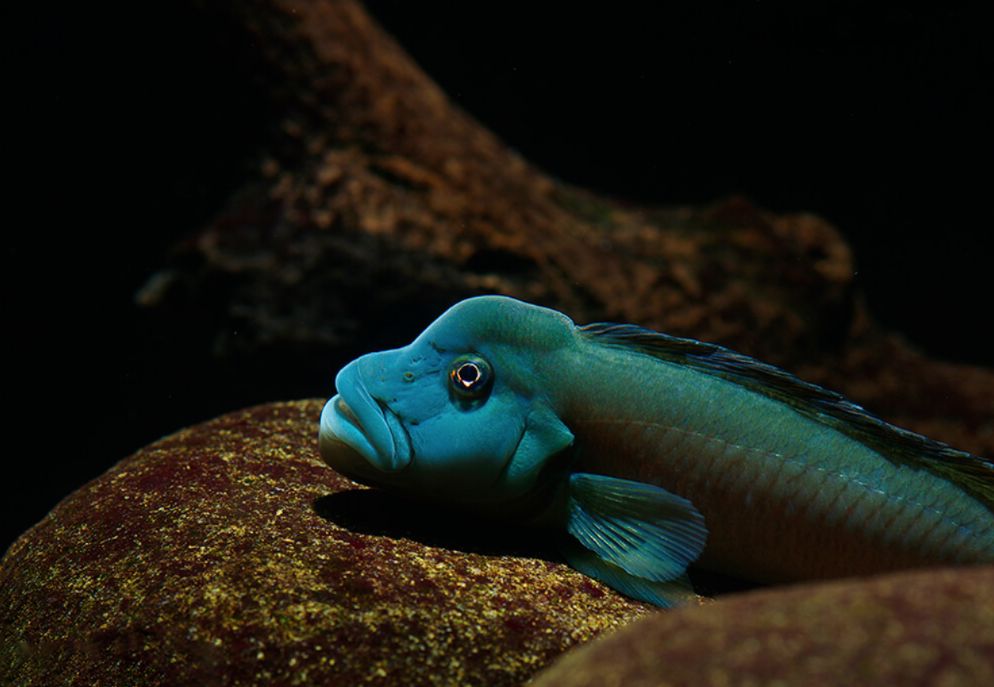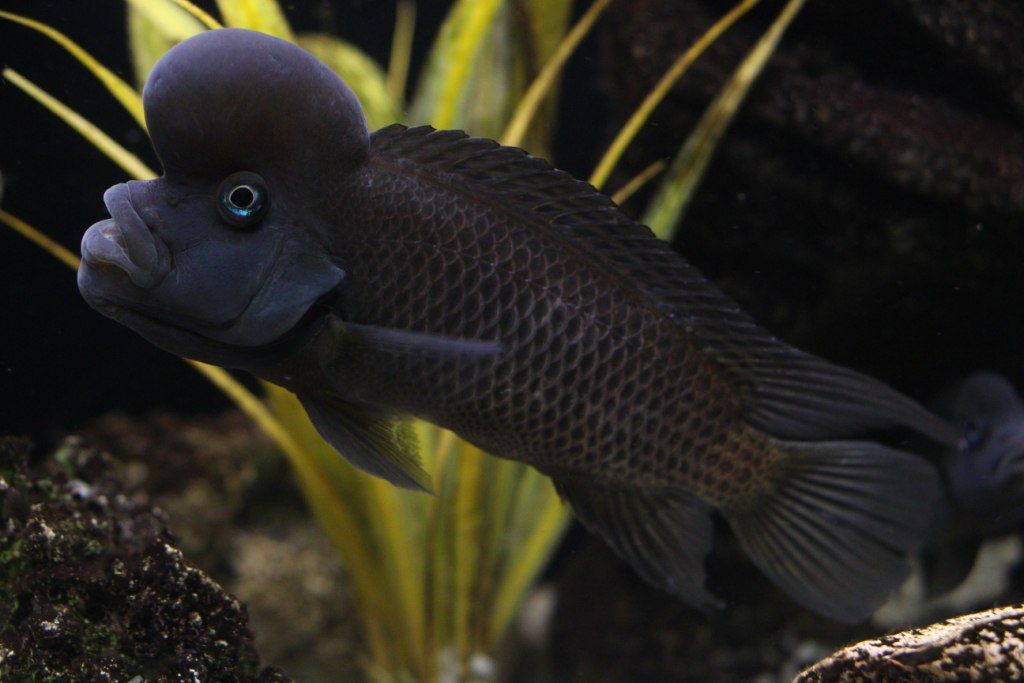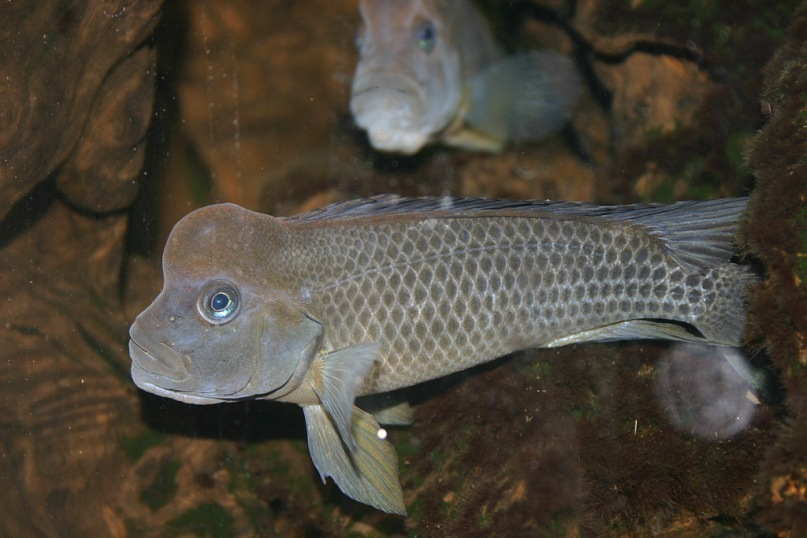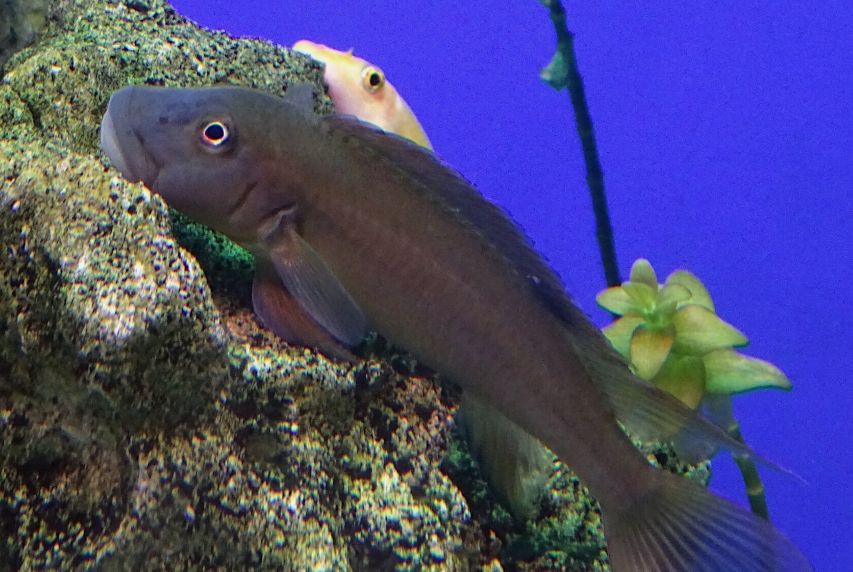The buffalo head cichlid, known for the distinctive hump on the forehead of males, showcases unique physical traits that set it apart from many other fish. While such features are now seen in various species, like the flowerhorn, the pronounced forehead hump of the buffalo head cichlid was quite unusual in earlier times. Additionally, these cichlids are notable for their unique swimming style, characterized by a more deliberate and less frantic movement compared to other cichlids, making them intriguing to observe in an aquarium setting.

Contents
Habitat in the wild
The buffalo head cichlid is part of the family Cichlidae, one of the largest and most diverse families of freshwater fish, encompassing hundreds of species. Cichlids are renowned for their unique behaviors, vibrant coloration, and extensive distribution across freshwater habitats, particularly in Africa, South America, Central America, and parts of Asia.
Within this family, the genus Steatocranus includes the buffalo head cichlid, which was first described by Poll in 1939. This species inhabits regions in Africa, specifically from Malebo Lake to the Congo River Basin, with a preference for the Malebo Pool, located upstream from the Victoria Waterfall. In their natural habitat, buffalo head cichlids thrive in slow-moving or stagnant waters that have rocky substrates and ample hiding spots. The water is typically warm, with a slightly acidic to neutral pH.
Buffalo head cichlids often occupy areas with minimal currents, where they find refuge among rocks, crevices, and submerged roots. These hiding spots are crucial for establishing territories and protecting themselves from predators. The aquatic vegetation in their environment may be sparse, and the water can be turbid due to organic material, contributing to their unique adaptations.
Notably, buffalo head cichlids exhibit a distinct swimming style that resembles the bottom-dwelling behavior of peacock gudgeons. They swim jerkily, a reflection of their adaptation to living in basins with strong water flow. Their fins provide support, while a reduced swim bladder increases their weight, allowing them to resist stronger currents effectively.

Description
Physical Characteristics
The lionhead cichlid features an elongated body with a prominent head and striking blue eyes. Males develop a distinctive nuchal bump on their heads as they mature, which becomes more pronounced with age. Their body color typically ranges from olive-green to brown, with blue or gray markings. Recently, dark-blue variants have also become popular among aquarists.
Size
The average size of male lionhead cichlids is around 11 cm, while females tend to be slightly smaller, averaging about 8 cm. Larger specimens can reach up to 15 cm in length. While their size makes them suitable for smaller aquarium setups, it’s crucial to provide adequate space and compatible tank mates to promote their well-being and minimize territorial behaviors. As with most fish species, individual sizes can vary, but the ranges mentioned above are typical for adult lionhead cichlids.
Lifespan
In captivity, with proper care and optimal conditions, lionhead cichlids can live an average of 5 to 8 years. Key factors that influence their longevity include regular water changes, effective filtration, and careful monitoring of water parameters. Providing a stable and clean environment is essential for enhancing their lifespan and overall health.
| Characteristic | Description |
|---|---|
| Scientific Name | Steatocranus casuarius |
| Common Name | Lionhead cichlid, buffalo head cichlid, buffalo head fish, blockhead cichlid |
| Family | Cichlidae |
| Origin | West Africa, rivers and streams of Nigeria and Cameroon |
| Size | Approximately 3 to 4 inches (7 to 10 centimeters) |
| Lifespan | Around 5 to 8 years in captivity |
| Habitat | Slow-moving or stagnant waters with rocky substrates |
| Preferred pH | 6.5 to 7.5 |
| Preferred Temperature | 74°F to 78°F (23°C to 26°C) |
| Behavior | Territorial and can be somewhat aggressive |
| Diet | Omnivorous, feeding on small invertebrates and plant matter |
| Coloration | Brown, gray, or black with various spots and patterns |
| Aquarium Setup | Plenty of hiding spots, caves, rocks, and driftwood |
| Tank Mates | Compatible with other peaceful cichlids and similar-sized fish with caution |
| Breeding | Maternal mouthbrooders, females carry eggs and fry in their mouths |

Difficulties in keeping
The lionhead cichlid reaches a maximum size of about 11 cm, making it a suitable choice for aquarists with smaller tanks. While this species is not particularly demanding regarding water hardness and pH levels, it does require high water purity and adequate oxygen content. In the wild, these fish thrive in fast-flowing, clean streams, so replicating similar conditions in an aquarium is crucial for their health.
Care and keeping in a tank
Tank Size
For a single buffalo head cichlid or a pair, a minimum tank size of 20 to 30 gallons (75 to 113 liters) is suitable. However, these fish thrive best when kept in small groups. A group of 4 to 6 individuals requires a larger tank of at least 55 to 75 gallons (208 to 284 liters) to provide ample space and reduce aggression. A larger tank not only offers more swimming space but also allows for the establishment of territories, helping to minimize stress and aggressive behaviors among the cichlids.
Importance of Space
Providing sufficient space in the aquarium allows buffalo head cichlids to engage in their natural behaviors, such as exploring and establishing hierarchies. With adequate room, these fish can swim freely, which contributes to their overall health and well-being. Insufficient space can lead to increased territorial disputes, resulting in stress and potential injuries.
Water Parameters
Maintaining appropriate water parameters is essential for the health of buffalo head cichlids. The recommended parameters include:
- Temperature: Aim for a temperature range of 74°F to 78°F (23°C to 26°C). This temperature range simulates their native West African habitat, supporting their overall health and natural behaviors.
- pH Level: Buffalo head cichlids prefer slightly acidic to neutral conditions, with a pH range of 6.5 to 7.5. Regular monitoring will help keep the fish stress-free and encourage breeding behaviors.
- Hardness: General hardness (GH) should be between 4 to 10 dGH, and carbonate hardness (KH) between 2 to 8 dKH. These levels can be achieved with appropriate substrates and regular water changes, which can also help maintain stability.
- Ammonia and Nitrite: Both should be maintained at zero, as they are toxic to fish. Regular testing, especially during the cycling phase, is crucial for their survival.
- Nitrate: Nitrate is less harmful but should still be kept below 20-30 ppm through routine partial water changes to avoid long-term health issues.
Filtration and Aeration
Strong water flow and high oxygen content are essential for buffalo head cichlids, reflecting their natural habitat. A powerful, high-quality filter that creates strong water movement is necessary. Regular water renewals and substrate siphoning will help maintain water quality and clarity.
- Filtration: A filter rated for at least double the tank’s volume is recommended. This ensures efficient removal of waste and maintains water clarity.
- Aeration: Adding an air stone or air pump can enhance oxygen levels in the tank, promoting a healthier environment.
Substrate
The ideal substrate for buffalo head cichlids should mimic their natural habitat, consisting of sandy or fine gravel riverbeds with rocky areas. Avoid coarse or sharp substrates that may injure the fish during their digging and exploration behaviors.
- Substrate Depth: A depth of 1 to 2 inches is generally sufficient, allowing for digging without compromising water quality.
Decor
Buffalo head cichlids thrive in a rocky setup with plenty of caves and crevices for hiding. Arrange rocks to create stable hiding spots and territories. Ensure the rocks are securely placed to prevent collapse, which could harm the fish.
- Hiding Spots: Use a combination of natural and artificial decorations to create a diverse environment. Clay pots, PVC pipes, and commercially available caves can serve as excellent hiding spots.
Behavioral Notes
Due to their shy nature, buffalo head cichlids may not always be visible. Observers often see only their prominent heads sticking out from behind covers, as they prefer to spend much of their time hidden.
Playful Interaction: Buffalo head cichlids often engage in playful behaviors, such as chasing each other around the tank, which can be entertaining for aquarists. Providing a well-structured environment encourages these behaviors, contributing to their social dynamics.
Territorial Behavior: During breeding or when establishing dominance, males may become more aggressive, defending their territories. It’s essential to monitor interactions and be prepared to separate individuals if necessary.

Diet
Buffalo head cichlids are omnivorous fish, thriving on a varied diet that includes both animal and plant matter. In their natural habitat, they primarily consume small invertebrates, insects, crustaceans, and some plant material. To keep these cichlids healthy in a home aquarium, providing a balanced diet is crucial.
A good diet should include high-quality cichlid pellets or flakes specifically formulated for cichlids, as these should be a staple in their diet and provide essential nutrients. Offering occasional treats of frozen or live foods, such as brine shrimp, bloodworms, daphnia, and small insects, can help mimic their natural diet and promote vibrant health. Supplementing their diet with vegetable matter, like blanched spinach, peas, or zucchini, is also beneficial. While some buffalo head cichlids will graze on algae in the tank, providing additional vegetable options ensures they receive a well-rounded diet.
Variety is key, so rotating between different types of foods will help guarantee that they receive all necessary nutrients while keeping their diet interesting. It’s essential to avoid overfeeding buffalo head cichlids, as they can be prone to obesity and related health issues. Feeding them only what they can consume in a few minutes is advisable. Observing their behavior can help adjust feeding frequency as needed to ensure their health and well-being.
Interesting Facts About Their Diet
Buffalo head cichlids exhibit natural foraging behavior, often digging in substrates to find hidden food sources, mimicking their wild feeding habits. Their preference for a varied diet not only enhances their health but can also improve coloration, making them visually striking in the aquarium. In breeding scenarios, providing a rich and balanced diet can enhance the health of both the parents and their fry, increasing survival rates of the young fish. By following these dietary recommendations, aquarists can help ensure that buffalo head cichlids thrive and maintain their vibrant health in a home aquarium.
Tank mates
It is rather good-tempered to other fishes in a community tank. The main requirement is for the buffalo head cichlid not to have any competitors in the water bottom layers. Ideal tank mate is a fish that prefers upper or middle water layers. At that the fish shouldn’t be small so the cichlid won’t swallow it.
Lionhead cichlid can be kept with other not large sized cichlids, – for example, it can be firemouth cichlid or convict cichlid. But the tank has to be spacious enough in this case.
This cichlid forms a stable couple, so it often happens that the fish which has lost its match refuses to spawn with another fish. As for attitude to other cichlid fishes – they are territory-dependent ones, especially during their spawning period.
Distinguishing Male and Female Buffalo Head Cichlids
Distinguishing between male and female buffalo head cichlids can be challenging, especially when they are young or not in breeding condition. However, as they mature, certain physical and behavioral traits become more evident. Males typically grow larger than females, with the size difference becoming more noticeable at sexual maturity. During the breeding season, males may display more vibrant and intense coloration, developing brighter hues and patterns to attract mates. Their dorsal and anal fins are often more elongated and pointed compared to the more rounded fins of females.
Additionally, mature males exhibit a pronounced hump or forehead, contributing to their distinctive “buffalo-like” appearance. Behaviorally, males tend to become more territorial and aggressive during breeding, while females may show more submissive behavior. Although males often have a more prominent genital papilla, distinguishing the sexes accurately can still be subtle, requiring careful observation of their behaviors and physical traits.
Breeding Behavior
Buffalo head cichlids are known to spawn on substrates, although this is not their only method. They commonly lay eggs in pits or in the nooks and crevices of rocks, but the eggs, lacking a sticky shell, cannot adhere to surfaces. Keeping buffalo head cichlids with other species can stimulate their natural spawning behaviors and awaken parental instincts. However, for maximizing juvenile survival, it’s advisable to transfer the breeding pair to a dedicated spawning tank.
Courtship behavior is often discreet, taking place within caves, which can lead to aquarists not realizing they have juveniles until they emerge. The breeding couple typically selects a cave for this purpose; the female remains inside while the male guards the territory outside. When the male is ready to breed, he displays courtship behaviors, gently nudging the female to encourage her participation. Once she is ready, they enter the cave to lay and fertilize approximately 50 to 100 eggs, depending on her size.
After about three days, the juveniles hatch but remain hidden in the cave. Feeding juveniles is straightforward, as they can consume nauplii of brine shrimp along with flakes and granules, which are preferable. It’s important for the food to settle on the tank bottom, and with optimal water parameters and a balanced diet, the juveniles will grow rapidly.